A capacitor is a capacitor--or is it? Recent developments have produced a variety of new capacitor types and the old ones are not always what you might expect. Here's a rundown on how to solve capacitor replacement problems.
By Bernard B. Dalen
Capacitors have been changing. Recently the changes have been rather revolutionary, because silver and tantalum prices have skyrocketed. Silver is used in ceramic disc capacitors, and tantalum in tantalytic capacitors. Substitutes are being used increasingly.
Ceramic capacitors now come in large sizes ... up in microfarads. Aluminum electrolytics are being made with a wide variety of superior specifications, not only for computers, but for higher frequency use, higher ripple currents, higher temperatures, and lower leakages, but you cannot substitute one type of aluminum electrolytic for another. For example, the capacitors used in switching power supplies, or in TV flyback power supplies, have special fabrication methods.
The recent years have seen a whole new generation of plastic dielectric capacitors ... polystyrene, polycarbonate, polypropylene. And, there is a wider assortment of dielectrics for ceramic capacitors.
Do you know that some capacitors lose 90 percent of their capacitance at higher frequencies? Do you know what the letters, "Z5U" mean, on a discap? Do you know what to do when you can't get a replacement tantalytic capacitor? What is ESL?
Like everything else in electronics, capacitors are becoming more complicated. Time was that you could stock a few basic types of capacitors electrolytics, mica, paper and that was it. Now there are several types of ceramics, several types of plastics, several types of ceramics, several types of electrolytics, plus tantalums . . and subdivisions like metallized, dual dielectric, etc. What can be substituted for what?
This article will help you update your capacitor knowledge, and facilitate capacitor substitutions. You will also learn the answers to the above questions, and many more that you may have asked.
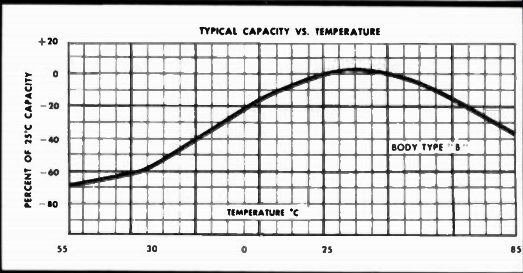
Fig. 1. The capacitance vs. temperature of a typical Z5U type ceramic capacitor
intended for bypass and audio coupling use. (Courtesy Radio Materials Corporation.)
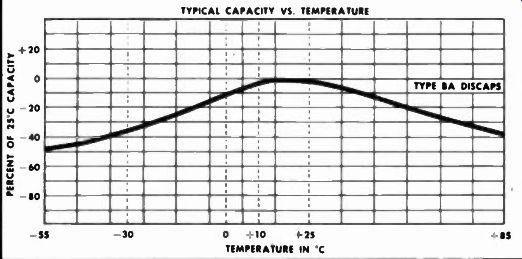
Fig. 2. The capacitance of an extended-temperature, ceramic capacitor otherwise
similar to the capacitor of Fig. 1. (Courtesy RMC.)
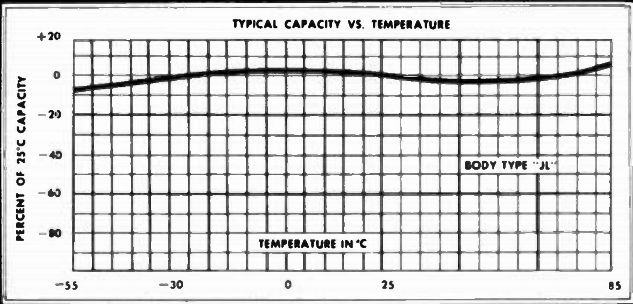
Fig. 3. The capacitance of a temperature stable ceramic capacitor, RMC type
JL. (Courtesy RMC.)
Why So Many Kinds of Capacitors?
Different capacitors are needed for different applications, with widely different essential characteristics.
Small bypass caps are needed for use with the power supply bus decoupling on digital printed circuit boards.
Spikes on the power bus can cause spurious triggering of flip-flops, etc.
Tuning capacitors require good "Q". Timing capacitors require low leakage Both require good stability with time and temperature.
Energy storage capacitors, for use with photoflash (strobe lamps), welding. etc., must be capable of many operating cycles at very high discharge currents.
Filter capacitors must be able to handle high ripple currents (which cause internal heating), in high ambient temperatures (next to power transformers), with very high reliability, since a filter short puts a power supply out of business.
Radio frequency bypass capacitors must have very low "equivalent series resistance" (ESR), and very low "equivalent series inductance" (ESL) ... otherwise they do not act as bypasses at frequencies where you expect them to have a low impedance! And, of course, everyone wants the smallest, lightest, cheapest capacitor possible.
Putting all these factors together, it becomes obvious that no one, or two, types of capacitors can fulfill all these varied needs. If cost were unimportant, we might be able to develop some sort of "ideal capacitor" which could do most of the jobs ... but the fact is that cost is very important to most manufacturers, so we have many capacitors, each doing just a few of the things ... but at lower cost.
The escalating price of metals has aggravated the situation. Silver was used in silver mica, and silver ceramics (discaps) ... tantalum was used in tantalytics, etc. Now we are using nickel in discaps, and specially processed electrolytics instead of tantalytics. If you are servicing a set with some of the original "pre inflation" capacitors, you may have to make a substitution, because the original parts are not available. Again, cost is the root cause.
A Look at Ceramic Capacitors
Ceramic capacitors are being used more frequently now, because recent advances have made them available in larger capacities (over one microfarad). The dielectric is some form of titanate (metallic oxide) formed at very high temperature. Ceramics come in three standardized classes.
Class 1 capacitors are temperature compensating, and are so marked... for example, "NP0" which means "Negative-Positive Zero" (negative and positive temperature coefficients are zero), or, "N750" (negative temperature coefficient of 750 parts per million, per degree centigrade). They are very predictable, but by comparison to the other classes, are quite large for their small capacitance.
This is because other characteristics have been sacrificed for temperature predictability, (a linear change of capacitance with temperature). They have very good "Cr for use in tuned circuits.
Class 2 ceramics are used for general purposes. Their temperature versus capacitance characteristics shows very NON-LINEAR changes, as compared with Class 1 materials ... These capacitors are much smaller than Class 1, for the same capacitance, because the dielectric constant is much higher, being five hundred or more. Class 2 ceramics have a lower 0 than Class 1, and the capacitance drifts with time, temperature, applied voltage, and frequency! (Some of them lose most of their capacitance at very low temperature). The higher capacitance Class 2 capacitors use very high dielectric constant material to achieve the capacitance rating, the "dielectric Constant" (K), being referred to as "High K," running over 4000! The "High K" units are often made to the "Z5U" temperature curve, which is suitable only for bypass applications requiring very little temperature stability, but with lots of capacity in a small package.
Class 3 capacitors have even higher Ks, putting greater capacity into a tiny package, but they are useful only in the audio frequency range, at low voltages.
One word of caution! I found some very weird effects when using very high K materials ... they make good transducers. Shock or vibration results in a large signal generated by the capacitor. (A form of piezoelectric effect). At any rate, I have used them as a "poor man's transducer." Wired as a vibration "mike," (high impedance), and affixed to a window, they make excellent alarm devices. If you flick one with your finger nail, in an audio circuit, be prepared to jump! Better yet, look at it with your scope ... it really puts out a signal.
Ceramics are now made in multi-layers, further increasing the capacitance ... to a whopping one microfarad, or even more.
The Class 1 ceramics are being used to replace mica capacitors, while the higher K units are replacing tantalums. The ceramics actually work better as bypasses at frequencies of several hundred kiloHertz and higher, since they have lower ESR and ESL ... but tantalums are more stable, and can be made in much higher values of capacitance ... thus tantalums are still in demand for timing circuits, etc.
Some manufacturers of ceramic capacitors are now switching from silvered ceramics to a nickel coating.
They claim that the product is just as good ... but in the past it has often taken years for time dependent effects to appear ... then, blooey! In the early days of transistors, failures occurred only after a period of time.
Upon opening the device, a purple color was noted where two different metals joined . . the phenomenon was promptly dubbed "purple plague," and it was a great mystery for a while.
Eventually it was traced to the migration of metals, and the problem was solved. So ... I am keeping my fingers crossed on the new substitutions until they have been proven in the field for a few years of actual use. However, in all fairness they seem to be working out well so far.
And Then There Are Electrolytics
. .. and electrolytics ... and electrolytics. You might say that the old aluminum electrolytic capacitor has a multi-personality problem.
Depending upon how it is made and processed, the alumalytic can be many different things. for many different uses. In the past, the alumalytic was the first choice for really high values of capacitance, the only choice for voltages up to 450 volts, . .. and the best choice for low cost ... providing that the temperature was less than 85 degrees Centigrade, and the frequency was low ... and providing that you could stand quite a bit of dc leakage. But that has all changed. The manufacturers are moving in to fill the shortage of low cost tantalytics. Using modern methods, and high purity aluminum, alumalytics now come in several varieties.
You have to read the manufacturers specifications to find out what each product does now. Some electrolytics are specifically tailored for use with switching type power supplies. They must have low ESL because of the high frequency ripple, be able to tolerate amperes of ripple current (the input is a square wave), and handle lots of internal heating.
Other electrolytics are processed for stability with time and temperature, and low leakage. They are intended for replacing tantalytics, and no others will do. So don't just go to your favorite distributor and ask for an "Electrolytic" anymore. Be darn sure that you understand what the use is, and buy the product rated for that use! If the capacitor is going into an auto radio, in the north country. you had better get one rated for minus 55 degrees centigrade ... the others lose much of their capacity before the temperature gets that low. On the other hand, if the cap is going into a hot spot, note that some makers provide units that operate up to 105 degrees C. More ... you will be very disagreeably surprised to find that some original equipment capacitors are very small for the capacity ... and in a tight spot, your favorite brand might not fit at all. Some makers specialize in extra small capacitors.
(Many of these electrolytics are made in foreign countries, which makes your job a little tougher!). As a matter of fact, choosing an electrolytic capacitor has become a first rate technical problem, due to the various specifications involved ... I would suggest that you obtain the full specifications for the lines of capacitors that you stock, by writing directly to the manufacturer, and guarantee that you will be surprised by what you learn.
A word of warning about alumalytics. They have rubber or synthetic seals. The seals are affected by certain solvents, which occur in some tuner sprays, contact cleaners, etc. If the solvent gets to the seal, it will fail prematurely. The small upright type units which mount on printed circuit boards by their leads, are also affected by the use of solder flux removers. I never use anything but pure alcohol to remove flux, because many flux removers attack plastics, seals, etc.
(In an emergency, you can use some of the medical brandy which is sometimes found in service shops . usually in the office.)
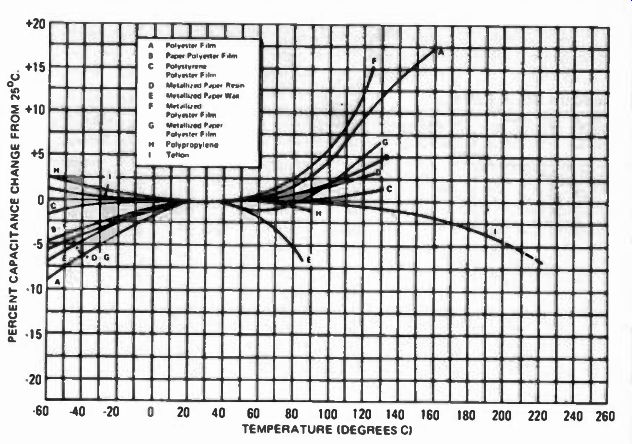
Fig. 4. Capacitance/temperature characteristics of various types of film capacitors.
(Courtesy Connell Dubilier.)
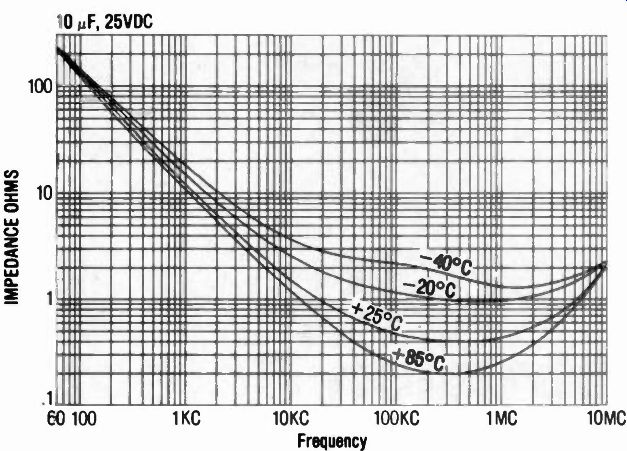
Fig. 5. Impedance/Temperature curves of a typical general purpose electrolytic
(Mallory Type TT,. Note the logarithmic impedance scale. (Courtesy Mallory
Distributor Products Division.)
Tantalums
Tantalytic capacitors are supposed to be a form of electrolytic capacitor ... but they are a different breed of cat.
While alumalytics are tolerant of transient overvoltages, and are self healing to a certain extent, tantalytics are not. If you go only a few volts over the rating, they fail, and fast.
On the other hand they have the ability to function at frequencies much higher than ordinary electrolytics.
Tantalytics are the first choice for timing circuits, and where long term stability in a high value of capacitance is required. The leakage current is smaller than that of electrolytics and best of all, the tantalytic works up to about 175 degrees C! The tantalum devices do not have to use rubber vent seals, they can be hermetically sealed, and therefore have a much longer life expectancy than alumalytics. For these reasons tantalums are used in critical applications where tough environmental conditions exist, or when long life is a prime factor. In such cases, you cannot substitute .. but in run of the mill hi fi, etc., a modern alumalytic designed for replacement of tantalums will do nicely. Of course if you have any doubts at all ... put in a tantalum and charge the customer for the extra cost of purchase, pickup, etc. It's better than a recall.
Remember, don't push tantalums on voltage ratings. Allow for transients, etc. Never use a rating less than the one on the original part ... not even by a few volts! On the same subject, tantalums cannot stand reverse voltage ... not even a few volts! Electrolytics can take small reverse voltage transients, for a short time ... but not tantalums. If you think you are having reverse transients, put a reverse diode across the tantalum to protect it.
If you put two tantalytics in series, reverse polarized, to make a non polar capacitor, be sure to put a reverse diode across each one. This is good practice for electrolytics too, but in he past this has sometimes been omitted because the leakage through the electrolytic tended to provide a "sneak path" ... Due to the low leakage of tantalytics, you cannot rely on that anymore. (Since non-polar electrolytics and tantalytics are used in TV sets and hi fi, and are seldom on the shop parts shelf, you may want to remember this little hint.)
Dielectric Absorption
If you charge a capacitor, then short it for a few seconds, and let it stand a while, you will often find that it has "built up a charge" again. (How many times have you been zapped that way with a picture tube?) What happens is that the dielectric has a residual charge stored in it. Of course this can be a real problem in circuits which require periodic charge and discharge of the capacitor, as in timing applications. In instrumentation using the single or dual ramp system of capacitor charge as a basis, the designer depends upon the complete discharge of the capacitor as a starting point ... i.e., the capacitor starts from zero volts. If there is appreciable dielectric absorption, there may be quite a voltage on the capacitor after it has been discharged to "zero." Capacitors are often chosen for their low dielectric absorption characteristic, in applications where this is important. Polystyrene capacitors have low dielectric absorption, along with extremely low leakage, but must be used at lower temperatures than some of the other plastic film capacitors.
Plastics
Today we have polyester, mylar, polycarbonate, polystyrene, and polypropylene film dielectrics. The old paper dielectric has been combined with a plastic film, ("dual dielectric" capacitor, which is very reliable). The trouble with paper dielectric capacitors is that the paper is oil impregnated (oil filled capacitors), and the oil used is detrimental to human health.
Eventually these capacitors leak, and cause a health hazard. To get around this, these capacitors are often put into metal sealed cans, which are rather heavy. Other than this objection, the oil filled paper capacitors are very good for high voltage use, as in transmitters ... and they are quite stable, with very, very, long life.
The reason the film capacitors are taking over is that they have no oil, do not need cans, and thus are quite small and light. They also work at higher frequencies without heating, and thus are well suited for switching and scan rectified supplies which are so popular today.
Film capacitors have widely different characteristics, depending upon the plastic used, and the type of construction. Some can handle very large ripple currents, at fairly high frequencies. Other pack a lot of capacitance into a small volume. Due to their variety, it is impossible to catalog them here. Suffice to say that you need to recognize that all plastics are not alike, and you must be very careful in substituting plastics.
Plastic film polystyrene will soften and melt where mylar runs merrily along. But mylar has much higher dielectric absorption. I think you get the idea... Now you know why some color TV manufacturers have "special" capacitors for use in horizontal deflection circuits, marked, "Use exact replacement part only!" The real problem seems to be that capacitor manufacturers selling their products to the consumer electronics repair shops, do not include even the barest applications information. You have to request this sort of information, which is available, directly from the manufacturer. Your local distributor often doesn't even know it exists! This is classified as, "Engineering Information." Unfortunately the service technician today is often an AA, but seldom treated as such. Service shops are expected to have a very clean crystal ball, which furnishes all manner of technical information. Some of the set manufacturers have provided this sort of information but this happens all too rarely.
Thus the ball stops ... in YOUR lap, as usual. With Yankee ingenuity, great perseverance, lots of experience, etc., the set eventually is fixed ... the hard way. Once again, it is up to you to stay abreast of all the technical developments. Good luck!
(source: Electronic Technician/Dealer)
Also see: